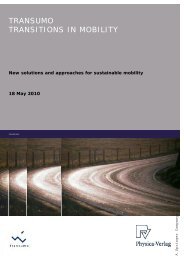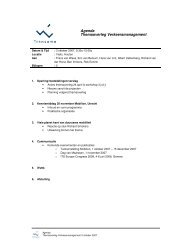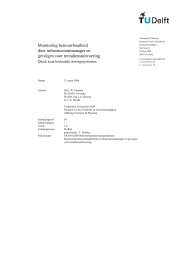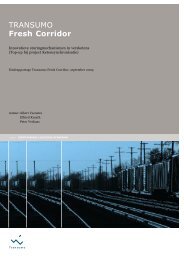Casestudie Breakdown prediction Contell PILOT - Transumo
Casestudie Breakdown prediction Contell PILOT - Transumo
Casestudie Breakdown prediction Contell PILOT - Transumo
Create successful ePaper yourself
Turn your PDF publications into a flip-book with our unique Google optimized e-Paper software.
could be: “The mean increase of a freezer’s electric power consumption is about 5%<br />
per degree room ambient temperature”.<br />
Functional models use functions to describe the existing behavior. ([Berthold99], p.<br />
172) Finding a functional description can be very difficult and is not always possible.<br />
A functional model of the freezer’s electric power consumption would allow a<br />
calculation for every given room temperature. Furthermore, it could help predicting<br />
malfunctions of a cooling device by just comparing current behavior to the describing<br />
function.<br />
Most powerful and detailed are analytic models. They describe coherences by the<br />
use of algebraic or differential equations. This allows a very detailed description of<br />
outputs for all kinds of imaginable inputs. ([Berthold99], p. 172) As already pointed<br />
out in section 2.4.1, many in- and outputs and their coherences are unknown due to<br />
very few sensors. That is why it seems to be impossible to find analytic models with<br />
the currently available datasets.<br />
Hence, this diploma thesis will first of all focus on possibilities to create statistical and<br />
functional models to gain more detailed information of monitored cooling devices.<br />
Only in case of reaching a degree of total information with this kind of models, an<br />
attempt to determine an analytic model would be useful.<br />
5.2 Different Kinds of Statistical Analysis<br />
The general purpose of statistical analysis is to provide information to advance<br />
important decisions. The main idea is to improve the quality of the decision making<br />
process by reducing uncertainties as good as possible. In general, statistics is<br />
divided into two branches: ([Holland01], p. 3)<br />
1. Descriptive statistics<br />
2. Inferential statistics<br />
Descriptive statistical methods describe large available datasets. Their main purpose<br />
is to summarize and to evaluate them. Another important task is the filtering of most<br />
important facts to get an overview of the underlying dataset. Typical results of<br />
descriptive statistical methods are statistical measures like the mean or the standard<br />
deviation for instance. The results are presented in form of a table or a graph to offer<br />
a quick overview. ([Holland01], p. 3)<br />
57
















